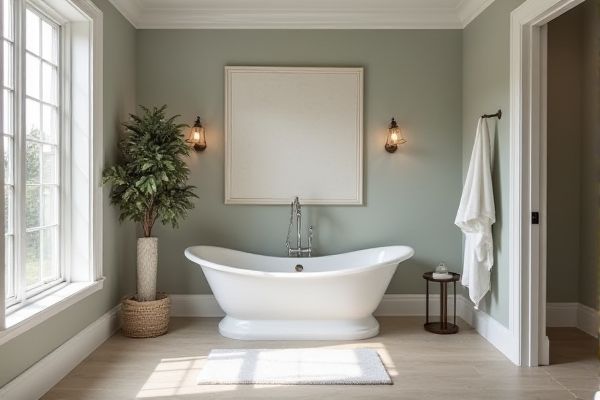
Freestanding tubs offer a stylish centerpiece that is easy to install and allows flexible placement, while built-in tubs provide a more integrated look with added storage and often better water retention. Discover which tub best fits your bathroom design and lifestyle by reading the rest of this article.
Table of Comparison
| Feature | Freestanding Tub | Built-in Tub |
|---|---|---|
| Installation | Requires floor space; flexible placement | Built into walls; requires alcove or surround |
| Design | Standalone, stylish, focal point | Integrated, space-saving, traditional look |
| Space Requirements | Needs more open bathroom area | Fits into smaller or confined spaces |
| Maintenance | Accessible sides for cleaning | Harder to clean around edges and corners |
| Cost | Generally higher upfront and installation cost | Typically more affordable and easier to install |
| Plumbing | Exposed plumbing or floor-mounted | Concealed plumbing behind walls |
| Comfort | Deep soaking tubs, ergonomic shapes | Varied depths; often shallower than freestanding |
| Resale Value | Can increase appeal in luxury markets | Standard option; neutral market impact |
Introduction to Freestanding and Built-in Tubs
Freestanding tubs offer a stylish centerpiece with their standalone design, providing flexibility in placement and a modern aesthetic. Built-in tubs are integrated into the bathroom structure, often surrounded by tile or other materials, maximizing space efficiency and offering options for added storage or seating. Your choice depends on bathroom layout, design preferences, and how you balance elegance with practical space usage.
Design and Aesthetic Appeal
Freestanding tubs offer a striking centerpiece that enhances the bathroom's visual appeal with their sculptural, standalone design and variety of shapes. Built-in tubs blend seamlessly with surrounding surfaces, providing a sleek, integrated look that complements modern or traditional decor while maximizing space efficiency. Choosing between the two depends on whether you prioritize statement-making style or subtle, cohesive design harmony.
Space and Placement Considerations
Freestanding tubs offer flexibility in placement, allowing you to position them anywhere with sufficient floor space, making them ideal for larger bathrooms or unique layouts. Built-in tubs require installation against walls or within alcoves, maximizing space efficiency and providing integrated storage options such as shelves or ledges. Your choice depends on whether you prioritize spatial versatility or optimized use of limited bathroom areas.
Installation Process and Requirements
Freestanding tubs require minimal structural modifications and can be installed anywhere with proper floor support and plumbing access, making them ideal for flexible bathroom layouts. Built-in tubs need more extensive installation, involving framing, wall reinforcement, and precise plumbing connections, often requiring professional expertise. Your choice depends on the desired aesthetic and the complexity you're willing to manage during installation.
Comfort and Ergonomics
Freestanding tubs offer enhanced comfort and ergonomics by providing ample space and allowing for more natural body positioning, making it ideal for long, relaxing soaks. Built-in tubs, while space-efficient, often have constrained edges and require sitting in a fixed position, which may limit comfort for some users. Ergonomic design in freestanding tubs often includes contoured shapes that support the back and neck, whereas built-in tubs prioritize functionality over relaxation.
Material and Durability Comparison
Freestanding tubs are often crafted from materials like acrylic, cast iron, or stone resin, offering a blend of durability and aesthetic appeal, with cast iron providing exceptional longevity and heat retention. Built-in tubs typically use acrylic or fiberglass, which are lightweight and budget-friendly but may be prone to chipping or discoloration over time. Your choice depends on balancing durability needs with style preferences, as freestanding tubs tend to withstand wear better but require more space and maintenance.
Cleaning and Maintenance Needs
Freestanding tubs require more careful cleaning around their base and exterior as they are accessible from all sides, making it easier to spot and remove dirt but also demanding regular attention to prevent dust accumulation underneath. Built-in tubs have enclosed sides, which can limit cleaning access and potentially harbor mold or mildew in tight corners or grout lines, requiring consistent scrubbing and ventilation to maintain hygiene. Your choice impacts maintenance routines, with freestanding tubs offering easier surface wiping and built-in tubs demanding thorough cleaning of surrounding seals and tiles to prevent buildup.
Cost and Budget Factors
Freestanding tubs typically have higher upfront costs due to their design and require additional plumbing work, increasing installation expenses compared to built-in tubs. Built-in tubs are generally more budget-friendly, benefiting from standardized sizes and easier installation within existing alcoves or enclosures. Homeowners with limited renovation budgets often prefer built-in tubs for their cost efficiency and simpler integration with bathroom layouts.
Resale Value and Market Trends
Freestanding tubs often boost resale value by adding a modern, luxurious focal point that appeals to homebuyers seeking stylish bathroom upgrades. Built-in tubs typically align with traditional designs and can maximize space, appealing to buyers prioritizing functionality and cost-effective renovations. Your choice impacts marketability, with freestanding tubs trending upwards in high-end markets, while built-ins remain popular in suburban homes.
Which Tub is Right for Your Bathroom?
Freestanding tubs offer a striking centerpiece with flexible installation, ideal for spacious bathrooms and modern designs, while built-in tubs maximize space efficiency with integrated surrounds and storage options, suited for smaller or traditional layouts. Consider bathroom size, plumbing location, and design preferences to determine the best fit; freestanding tubs require ample clearance and often higher installation costs, whereas built-in tubs provide easier maintenance and better water containment. Evaluating these factors ensures you select a tub that balances aesthetics, functionality, and your bathroom's unique requirements.
 homyna.com
homyna.com